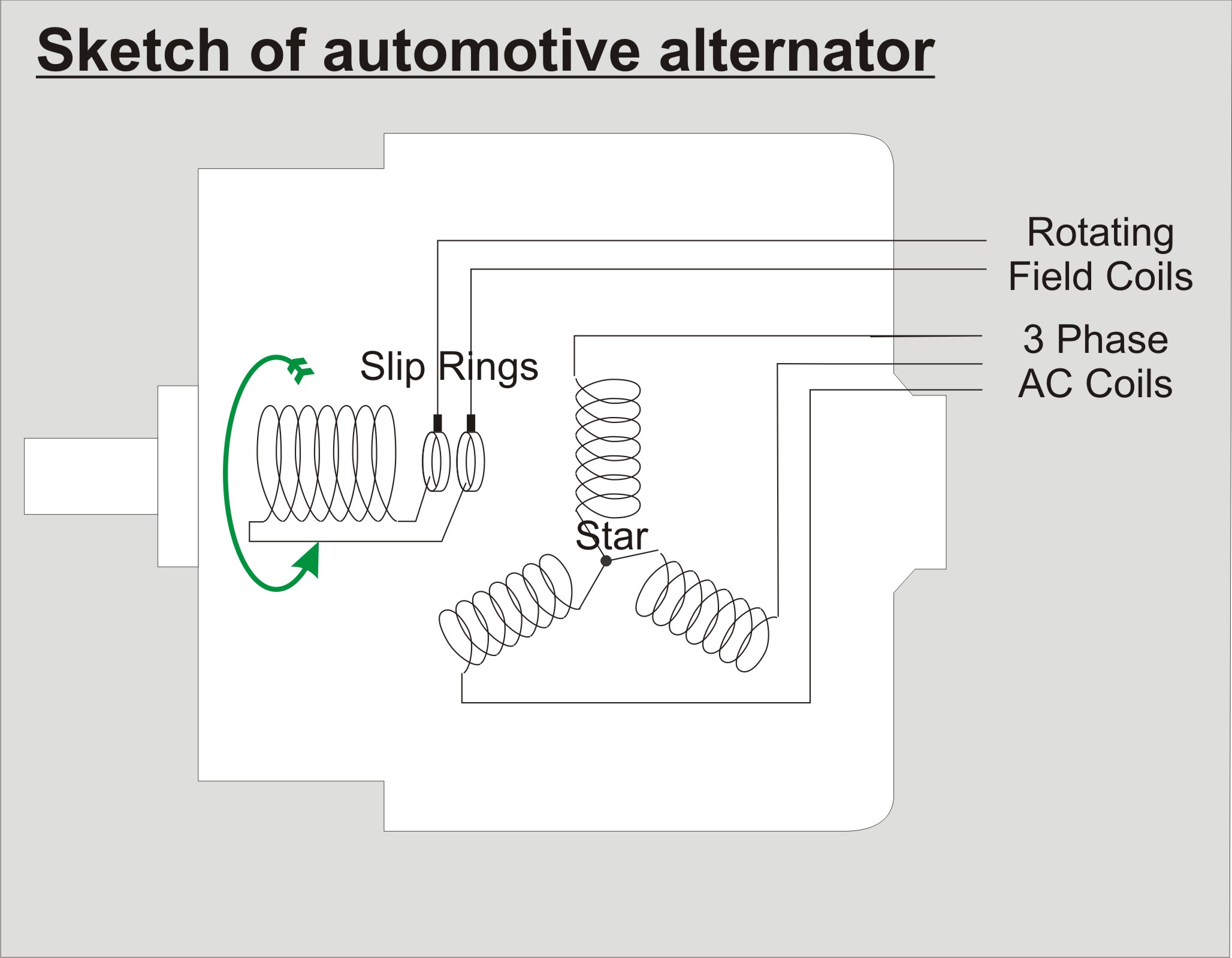Large Brushless Motors using Automotive Alternators
An automotive alternator can be converted into a semi-brushless motor.
I was looking at a stripped alternator last night and I wondered if anyone on this forum has thought about doing this. There are people on the web offering kits for converting the mechanical part (which is quite easy) but the electronics is the obstacle. You would need to produce a 3 phase sine wave of 15 volts and 75 amps. The unit would consume about 1100 watts and probably produce 1hp (mechanical). If you were enterprising, you could get one of those 24V 200A monster alternators used on busses – 30V, 6Kw, 6hp(mechanical)!!!
If you wanted more efficiency, you could wire your 12V unit “Delta” and run it off 24 volts.
It’s only semi-brushless because the magnetic core is provided by the field windings rather than magnets and this requires slipper rings.
I am told you can pick up an alternator from a US breaker for about US$15 but the electronics will cost quite ·a couple of clips (in South Africa, a clip is 100 notes held by a paperclip)
I was fascinated but I’m sticking with induction brush motors for now because my electronics isn’t up to the challenge of 3 phase sine wave at 75 Amps…
Kinf regards from the dark continent
John Bond
▔▔▔▔▔▔▔▔▔▔▔▔▔▔▔▔▔▔▔▔▔▔▔▔
I was looking at a stripped alternator last night and I wondered if anyone on this forum has thought about doing this. There are people on the web offering kits for converting the mechanical part (which is quite easy) but the electronics is the obstacle. You would need to produce a 3 phase sine wave of 15 volts and 75 amps. The unit would consume about 1100 watts and probably produce 1hp (mechanical). If you were enterprising, you could get one of those 24V 200A monster alternators used on busses – 30V, 6Kw, 6hp(mechanical)!!!
If you wanted more efficiency, you could wire your 12V unit “Delta” and run it off 24 volts.
It’s only semi-brushless because the magnetic core is provided by the field windings rather than magnets and this requires slipper rings.
I am told you can pick up an alternator from a US breaker for about US$15 but the electronics will cost quite ·a couple of clips (in South Africa, a clip is 100 notes held by a paperclip)
I was fascinated but I’m sticking with induction brush motors for now because my electronics isn’t up to the challenge of 3 phase sine wave at 75 Amps…
Kinf regards from the dark continent
John Bond
▔▔▔▔▔▔▔▔▔▔▔▔▔▔▔▔▔▔▔▔▔▔▔▔



Comments
Without worrying too much about generating 3-phase Ac, the alternator will work quite nicely as a stepper motor.
I converted a bus alternator by applying constant DC to the rotor then drove each of the three phases with the output of a stepper driver circuit made up with a counter chip (use a Stamp now). The steps were quite big and clunkly but there was great torque!
I poked around on the stator to find the star point which was connected to +12v. Each phase was switched to negative with a 2n3055 transistor (I'd use a FET now). I also put a small resistor (2 ohms, 10 watts) in series with each phase to limit the maximum phase current to 5 amps or so.
Cheers,
▔▔▔▔▔▔▔▔▔▔▔▔▔▔▔▔▔▔▔▔▔▔▔▔
Tom Sisk
http://www.siskconsult.com
·
Is there anything you haven't done!!!
Using an alternator as a stepper·is very interesting, does it come out as a·36 step/Rev motor (12 magnetic fields powered by 3 phases) or a·12 step unit.·Can one·drive it at a lot higher Amps. The automotive alternator I've got lying round is rated at 90 Amps.
Thanks again for your amazing advice - I never thought about a giant stepper.
John
▔▔▔▔▔▔▔▔▔▔▔▔▔▔▔▔▔▔▔▔▔▔▔▔
Oh yeah, there's still lots of things to try!
The number of steps is relatively low and your calculation of 36 seems about right.
More amps are better. You should be able to go as high as your transistors can stand it. You've got me thinking again, so I might see if I can dig it out and update it with a Stamp.
Cheers,
▔▔▔▔▔▔▔▔▔▔▔▔▔▔▔▔▔▔▔▔▔▔▔▔
Tom Sisk
http://www.siskconsult.com
·
He says he has done this modification a couple of times for farmers from the remote areas near here. They link it up to the PTO on their Massey Ferguson Tractors and use it for welding, up to 200Amps he claims but that seems a bit of a wild claim. I've seen the farmers using them and the poor tractor jumps as they strike the arc. There are still a couple of those British Massys (not Canadian) –that were made in the early 50s and were fitted with the Triumph TR3 sports car engines, cute little grey machines that will do anything you ask...
Hey Tom - you got me moving in an entirely new direction. Link the alternator to my 10:1 worm gearbox and I get just more than twice the resolution I need, plus more torque than I can handle. I wonder if I’ll be able achieve 300Rpm (5 revs a second) - sounds fast!
▔▔▔▔▔▔▔▔▔▔▔▔▔▔▔▔▔▔▔▔▔▔▔▔
I'd be interested in your progress.
Used as a welder, the limitation would likely be the diode current rating. If they're not installed, I think your electrician could be right. The beauty of alternators is that they will sort of self-limit by distorting the internal magnetic fields when the iron begins to saturate. Thats the other potential limitation; theres not much iron in the stator, so once its saturated (magnetically) driving extra current through the windings just heats up the coils.
When I did my project, it was for a an electric winch; just like yours, it was a worm drive affair.
Ah, TR3's! Not too many ever made it here, but I used to work on TR4A's, TR6, Spitfires, sprites, etc.
Cheers,
▔▔▔▔▔▔▔▔▔▔▔▔▔▔▔▔▔▔▔▔▔▔▔▔
Tom Sisk
http://www.siskconsult.com
·